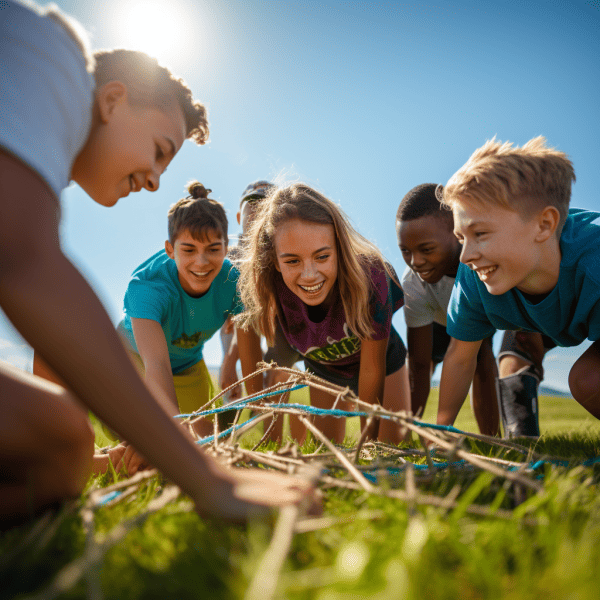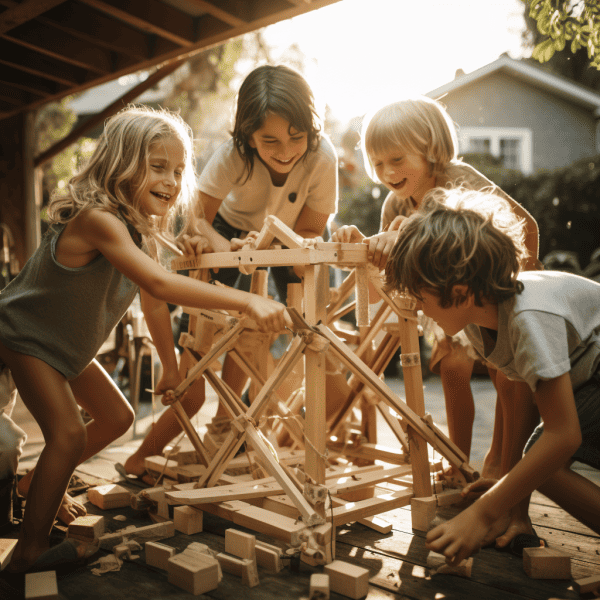
Fun Problem Solving Team Building Activities for Middle School – Comprehensive Guide (2023)
- By admin
- 2023-08-23
- 0 comments
As a teacher, I know the importance of fostering teamwork and problem-solving skills in our middle school students.
That’s why I’m excited to share with you a collection of engaging activities that will not only bring your students closer together but also enhance their critical thinking abilities.
From icebreakers to decision-making simulations, these team-building exercises are designed to promote effective communication, collaboration, and reflection.
Get ready to empower your students with the tools they need to tackle challenges head-on and become confident problem-solvers.
KEY TAKEAWAY
What are problem solving team building activities for middle school?
Problem-solving team building (1) activities for middle school involve collaborative challenges like obstacle courses, puzzles, and role-playing, fostering communication and critical thinking among students.
Icebreaker Activities
Icebreaker activities are a great way to help middle school students get to know each other.
As an educator, I have found that these activities are not only fun and engaging but also serve as an important tool for creating a positive classroom environment.
Icebreakers provide an opportunity for students to interact with one another, break down barriers, and build trust within the group.
One effective icebreaker activity is the ‘Two Truths and a Lie’ game.
In this activity, each student takes turns sharing two true statements about themselves and one false statement.
The rest of the class then tries to guess which statement is the lie.
This activity encourages students to listen actively, ask questions, and make connections with their peers.
Another popular icebreaker game is ‘Human Bingo.’ Students are given a bingo sheet with various statements such as ‘Has traveled outside of the country’ or ‘Plays a musical instrument.’ They must then move around the room and find classmates who fit each statement until they get a full line on their bingo sheet.
This activity prompts students to engage in conversation and discover shared interests or experiences.
Overall, icebreaker activities play a crucial role in helping middle school students connect with one another at the beginning of the school year or when forming new groups.
By fostering communication, collaboration, and empathy from the start, these activities set a positive tone for future problem-solving team building exercises. (2)
Communication Exercises

Take a moment to reflect on how effectively you communicate with others during these exercises.
Communication is a crucial aspect of problem-solving team building activities, especially for middle school students.
These exercises provide an opportunity for students to develop their communication skills and learn the importance of effective collaboration.
During these activities, I have noticed that clear and concise communication leads to better results.
When everyone understands their roles and responsibilities, it becomes easier to work towards a common goal.
Active listening plays a significant role in effective communication as well.
By actively listening to others’ ideas and perspectives, we can foster a more inclusive and collaborative environment.
Moreover, using contractions in our language helps to create a more casual and friendly atmosphere during these exercises.
It allows us to connect with our peers on a personal level while still conveying important information.
This informal tone promotes open communication where everyone feels comfortable expressing their thoughts and opinions.
Critical Thinking Challenges

Using critical thinking skills is essential when facing challenges that require us to analyze information and make informed decisions.
As a middle school teacher, I have come across various critical thinking challenges that help my students develop their problem-solving abilities.
These activities not only engage them intellectually but also promote teamwork and creativity.
Here are five examples of critical thinking challenges that I highly recommend for middle school students:
- Logic puzzles: Solving complex puzzles requires logical reasoning and deduction skills.
- Debate tournaments: Encouraging students to research and present arguments helps them develop persuasive and analytical thinking.
- Scavenger hunts: This activity promotes problem-solving as students work together to decipher clues and find hidden items.
- Brainstorming sessions: Fostering an environment where ideas are freely shared helps students think outside the box and consider multiple perspectives.
- Case studies: Presenting real-life scenarios allows students to analyze information, weigh options, and propose solutions.
Collaborative Problem Solving Tasks
When tackling collaborative problem-solving tasks, you’ll discover that working together with your peers is not only effective but also enjoyable.
Collaborative problem solving involves a group of individuals coming together to solve a complex issue or challenge.
It requires active participation, effective communication, and the ability to work as a team.
One benefit of collaborative problem-solving tasks is that they promote critical thinking skills.
By working with others, you can bounce ideas off each other, analyze different perspectives, and come up with creative solutions.
This process encourages you to think critically and consider alternative approaches.
Another advantage of collaborative problem solving is the opportunity to learn from one another.
Each person in the group brings their unique set of skills, knowledge, and experiences to the table.
Through interaction and sharing ideas, everyone involved can expand their understanding of the problem at hand.
Additionally, collaborative problem-solving tasks foster teamwork and cooperation.
They require individuals to listen actively, respect others’ opinions, and contribute effectively towards achieving a common goal.
These activities help develop important interpersonal skills such as communication, empathy, and conflict resolution.
Overall, participating in collaborative problem-solving tasks not only enhances your problem-solving abilities but also strengthens your relationships with peers.
It creates an environment where everyone’s contributions are valued and fosters a sense of camaraderie within the group.
Decision-Making Simulations
In decision-making simulations, you’ll have the opportunity to practice making important choices and see the consequences of your actions.
These simulations are a valuable tool for developing critical thinking skills and problem-solving abilities.
Here are five key benefits of participating in decision-making simulations:
- Enhances decision-making skills: By actively engaging in realistic scenarios, you can improve your ability to analyze situations, weigh options, and make informed decisions.
- Promotes teamwork: Decision-making simulations often involve working with a team, fostering collaboration and communication skills while solving complex problems together.
- Builds resilience: Making decisions in a simulated environment allows you to learn from mistakes without real-world consequences, helping you develop resilience and adaptability.
- Increases self-awareness: The process of navigating through different scenarios encourages self-reflection, enabling you to gain insights into your own decision-making processes and biases.
- Provides practical experience: Decision-making simulations offer hands-on experience that can be directly applied to real-life situations.
By engaging in these simulations, students can gain valuable experience in making decisions under pressure while considering various factors.
This prepares them for future challenges where they will need to rely on their problem-solving abilities.
If you are curious whether games can be a part of problem solving activities or not, check it out.
Moving into reflection and debriefing exercises further enhances the learning experience by allowing participants to analyze their choices and identify areas for improvement.
Reflection and Debriefing Exercises
Moving into reflection and debriefing exercises after decision-making simulations allows me to gain insights into my own decision-making processes and identify areas for improvement.
These exercises provide an opportunity to reflect on the choices I made during the simulation, understand the reasoning behind those choices, and evaluate their effectiveness.
During the reflection phase, I analyze the outcomes of my decisions and consider alternative approaches that could have been taken.
This helps me understand the impact of different decisions and learn from any mistakes or missed opportunities.
By reflecting on my decision-making process, I am able to identify patterns or biases that may have influenced my choices and develop strategies to overcome them in future scenarios.
The debriefing exercises further enhance this learning process by allowing me to discuss my experiences with others who participated in the simulation.
Through open dialogue and sharing perspectives, we can collectively analyze our decision-making strategies, exchange feedback, and learn from each other’s successes and challenges.
Overall, these reflection and debriefing exercises are essential components of problem-solving team building activities as they encourage self-awareness, critical thinking, collaboration, and continuous improvement.
They enable me to refine my decision-making skills by gaining valuable insights from both individual introspection and group discussion.
Conclusion
In conclusion, problem-solving team building activities for middle school are like puzzle pieces coming together to form a vibrant masterpiece.
They allow students to break the ice, communicate effectively, think critically, collaborate seamlessly, and make decisions confidently.
These activities are like mirrors that reflect their growth and development as they navigate through challenges and obstacles.
Through reflection and debriefing exercises, students gain valuable insights and learn from their experiences.
Ultimately, these activities equip them with the necessary skills to tackle real-world problems with confidence and creativity.
Frequently Asked Questions
Why are problem-solving team building activities important for middle school students?
These activities help develop valuable skills like communication, problem-solving, creativity, and teamwork.
They promote a positive learning environment and enable students to think critically and work effectively in a group.
What are some examples of problem-solving team building activities for middle school?
Examples include building a bridge using limited resources, completing a puzzle together, creating and executing a skit based on a specific scenario, or designing a solution for a hypothetical problem.
How can educators facilitate problem-solving team building activities for middle school students?
Educators can provide clear instructions, establish an inclusive and supportive environment, encourage active participation, and facilitate discussions during and after the activities.
They can also debrief the experience to help students understand the skills acquired and how they can be applied in different contexts.
References
- https://en.wikipedia.org/wiki/Team_building
- https://icebreakerideas.com/problem-solving-activities/#:~:text=Group%20Problem%20Solving%20Activities%201%20Wool%20Webs%20Divide,Build%20a%20model%20out%20of%20building%20blocks.%20






